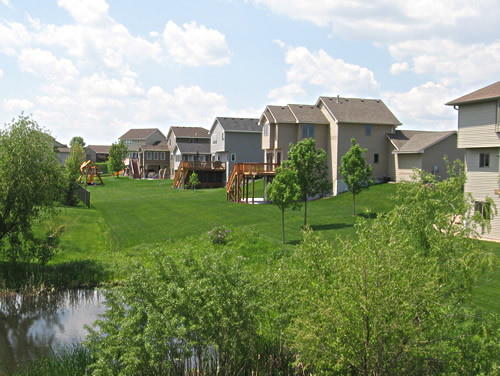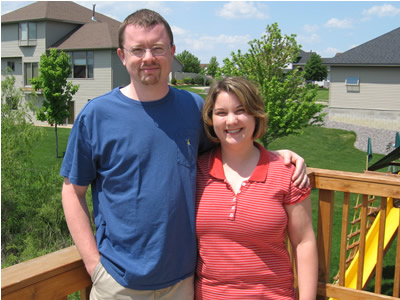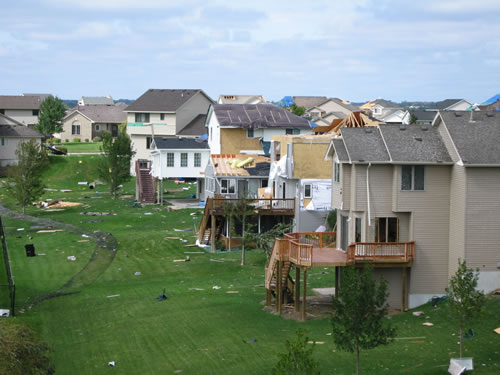This is the first of several posts this week on recovering from tornadoes.
| September 2006 |
|
|
| June 1, 2008 |
 |
Christy Paulson of Rogers, Minn., was upstairs after putting her sons to bed, watching TV and not paying much attention to the darkening weather outside on September 16 2006. Her husband, TJ, knew a late summer storm was coming and, because he “always liked storms,” he went downstairs to watch. (Listen)
“All of a sudden it hit pretty hard,” TJ, told me Sunday afternoon, both sitting in the dining room of their home which was in the path of a tornado that destroyed several homes in the neighborhood and killed a girl a few doors down. “All of the furniture on the deck went across the deck and just flew off. That was about the same time we felt the house shaking and we said, ‘OK, we’ve got to get to the basement.'” A 250 pound grill was launched off the deck and onto the back lawn.
“All of a sudden my ears plugged up,” Christy said. “I jumped out of bed and he was already running up the stairs. We each ran to a different kid’s bedroom. I could barely open my son’s door. We ran down the stairs as fast as we could. ”
“Right after we reached the bottom of the stairs,” TJ continued,” that’s when the windows in the back of the house here blew out.”
“That’s when I thought we were toast; I thought we were never going to make it,” Christy said.
Seconds later, by the time they reached the basement, it was over…
The Paulsons were lucky. The tornado hit 25 feet from their house. Their roof, siding, deck, windows, and most of the interior had to be replaced. Much of the damage was caused by the whirling rubble of their neighbors’ homes.
The Paulsons spent that night in their basement, then got up the next morning to clean up the mess. It was TJ’s birthday. The process of rebuilding took 6-8 months. (Listen)
They, like the other victims of the Rogers tornado, have a unique perspective on tornado recovery to share with the residents of Hugo, whose neighborhoods were ravaged by tornadoes a week ago.
For example:
But that check isn’t the extent of what an insurance company pays. After getting bids for various jobs, the insurance companies send supplemental checks. “We got five or six supplemental checks,” TJ said. “The initial check they sent out was about $40,000, but when all was said and done, our damage was over $100,000. You find more damage as you go.”
That was one of the frustrating parts for Christy. Every time a damage claim was filed, a different insurance adjuster showed up.

“They camped out right on our corner, for the entire time,” TJ said. “At night, in the morning, and we’re just trying to get our stuff cleaned up and I’d walk out of the garage with the dog. The only clean spot we had was the front yard. I’d be out walking the dog, and I’d have reporters come up and say, ‘Hey can we ask you a couple of questions?’ And all of a sudden a camera comes out, and they start bugging you, and I’m just trying to walk my dog!”
“The way they would ask the questions was so disrespectful,” according to Christy. “They immediately wanted to go to the little girl who died: ‘Did you know her? Did you ever meet her?’ It made you feel so bad the way that they did it; you could tell the story that they wanted.”
Now both pay close attention to the weather. They spent portions of Saturday in the basement when the storms went through.

